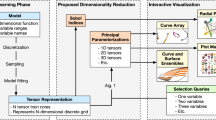Summary
We present a visualization method for the exploration of three-dimensional tensor fields. The representation of the tensor field on a one-parameter family of two-dimensional surfaces as stretched, compressed and bent piece of fabric reflects the physical properties of stress and strain tensor fields. The texture parameters as the fiber density and fiber direction are controlled by tensor field. The surface family is defined as a set of isosurfaces extracted from an additional scalar field. This field can be a “connected” scalar field, for example, pressure or a scalar field representing some symmetry or inherent structure of the dataset. The texture generation consists basically of three steps. The first is the transformation of the tensor field into a positive definite metric. In the second step, we generate a spot noise texture as input for the final fabric generation. Shape and density of the spots are controlled by the eigenvalues of the tensor field. This spot image incorporates the entire information defined by the three eigenvalue fields. In the third step we use line integral convolution (LIC) to provide a contin- uous representation that enhances the visibility of the eigendirections. This method supports an intuitive distinction between positive and negative eigenvalues and supports the additional visualization of a connected scalar field.
Access this chapter
Tax calculation will be finalised at checkout
Purchases are for personal use only
Preview
Unable to display preview. Download preview PDF.
Similar content being viewed by others
References
Brian Cabral and Leith Leedom. Imaging vector fields using line integral convolution. In: SIGGRAPH 1993 Conference Proceedings, 1993, pages 263–272.
Thierry Delmarcelle and Lambertus Hesselink. Visualization of s second order tensor fields and matrix data. In: Proceedings of the Visualization 1992 Conference, 1992, pages 316–323.
Robert B. Haber. Visualization techniques for engineering mechanics. Computing Systems in Engineering, 1(1), 1990, pages 37–50.
Lambertus Hesselink, Thierry Delmarcelle and James L. Helman . Topology of second-order tensor fields. Computers in Physics, 9(3), 1995, pages 304–311.
Lambertus Hesselink, Yuval Levy and Yingmei Lavin. The topology of symmetric, second-order 3D tensor fields. IEEE Transactions on Visualization and Computer Graphics, 3(1), 1997, pages 1–11.
Ingrid Hotz. Visualizing second order symmetric tensor fields by metric surfaces. In: Work in Progress of the Conference IEEE Visualization, 2001.
Ingrid Hotz. Isometric embedding by surface reconstruction from distances. In: Proceedings of the IEEE Visualization 2002 Conference, 2002, pages 251–258.
Ingrid Hotz, Louis Feng, Hans Hagen, Bernd Hamann, Boris Jeremic and Kenneth Joy. Physically based methods for tensor field visualization. In: Proceedings of the IEEE Visualization 2004 Conference, 2004, pages 123–130.
B. Jeremic, Gerik Scheuermann and Jan Frey. Tensor visualization in computational geomechanics. International Journal for Numerical and Analytical Methods in Geomechanics, 26, 2002, pages 925–944.
Gordon Kindlmann, David Weinstein and David Hart. Strategies for direct volume rendering of diffusion tensor fields. IEEE Transactions on Visualization and Computer Graphics, 6(2), 2000, pages 124–138.
Ron D. Kriz, Edward H. Glaessgen and J.D. MacRae. Visualization blackboard: visualizing gradients in composite design and fabrication. IEEE Computer Graphics and Applications, 15, 1995, pages 10–13.
W. C. de Leeuw and J. J. van Wijk. A probe for local flow field visualization. In: Proceedings of the Visualization 1993 Conference, 1993, pages 39–45.
James D. Murray. Mathematical biology I. An introduction, 3rd edition in 2 volumes. Springer, Berlin, 2002, ISBN: 0-387-95223-3.
J. Ou and E. Hsu. Generalized line integral convolution rendering of diffusion tensor fields. In: Proceedings of the 9th Scientific Meeting and Exhibition of the International Society for Magnetic Resonance in Medicine (ISMRM), 2001, page 790.
Allen R. Sanderson and Chris R. Johnson and Robert M. Kirby. Display of vector fields using a reaction-diffusion model. In: Proceedings of the IEEE Visualization 2004, pages 115–122, 2004.
Detlev Stalling and Hans-Christian Hege. Fast and resolution independent line integral convolution. In: SIGGRAPH 1995 Conference Proceedings, 1995, pages 149–256.
Xavier Tricoche, Gerik Scheuermann and Hans Hagen. Tensor topology tracking: a visualization method for time-dependent 2D symmetric tensor fields. In: A. Chalmers and T.-M. Rhyne, editors, EG 2001 Proceedings vol. 20(3) of Computer Graphics Forum. 2001, pages 461–470.
Alan Turing. The chemical basis of morphogenesis. Philosophical Transactions of the Royal Society London B, 237, 1952, pages 37–72.
Greg Turk. Generating textures on arbitrary surfaces using reaction diffusion. In: proceedings SIGGRAPH 1991, volume 25, pages 289–298. Addison Wesley, 1991.
David M. Weinstein, Gordon L. Kindlmann and Eric C. Lundberg. Tensorlines: advection-diffusion based propagation through diffusion tensor fields. In: proceedings IEEE Visualization 1999 conference,1999, pages 249–254.
Carl-Fredrik Westin, Sharon Peled, Hakon Gudbjartsson, Ron Kikinis and Ferenc A. Jolesz. Geometrical diffusion measures for MRI from tensor basis analysis. In: ISMRM 1997, 1997, page 1742.
Andrew Witkin and Michael Kass. Reaction-diffusion textures. In: Proceedings SIGGRAPH 1991, vol. 25, pages 299–308. Addison Wesley, 1991.
Xiaoqiang Zheng and Alex Pang. HyperLIC. In: Proceedings of the IEEE Visualization 2003 Conference, 2003, pages 249–256.
Xiaoqiang Zheng and Alex Pang. Topological lines in 3D tensor fields. In: Proceedings of the IEEE Visualization 2004 Conference, 2004.
Leonid Zhukov and Alan H. Barr. Oriented tensor reconstruction: tracing neural pathways from diffusion tensor MRI. In: Proceedings of the IEEE Visualization 2002 Conference, 2002, pages 387–394.
Author information
Authors and Affiliations
Editor information
Editors and Affiliations
Rights and permissions
Copyright information
© 2009 Springer-Verlag Berlin Heidelberg
About this chapter
Cite this chapter
Hotz, I., Feng, L., Hamann, B., Joy, K. (2009). Tensor-Fields Visualization Using a Fabric-like Texture Applied to Arbitrary Two-dimensional Surfaces. In: Möller, T., Hamann, B., Russell, R.D. (eds) Mathematical Foundations of Scientific Visualization, Computer Graphics, and Massive Data Exploration. Mathematics and Visualization. Springer, Berlin, Heidelberg. https://doi.org/10.1007/b106657_8
Download citation
DOI: https://doi.org/10.1007/b106657_8
Published:
Publisher Name: Springer, Berlin, Heidelberg
Print ISBN: 978-3-540-25076-0
Online ISBN: 978-3-540-49926-8
eBook Packages: Mathematics and StatisticsMathematics and Statistics (R0)




